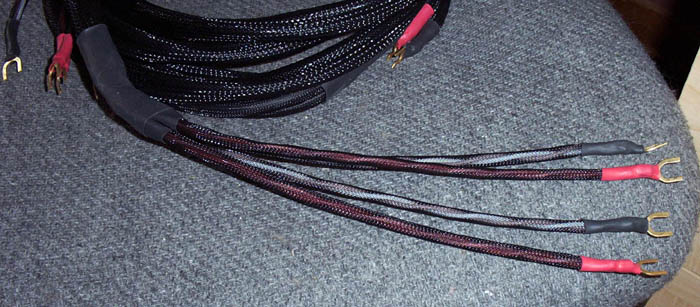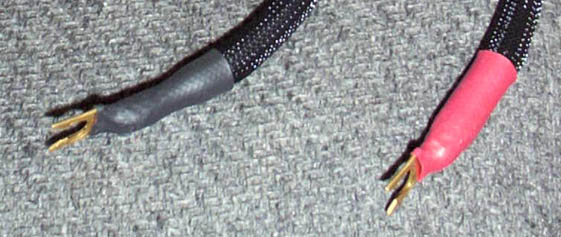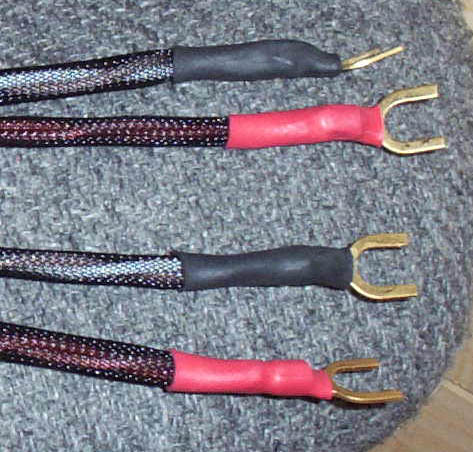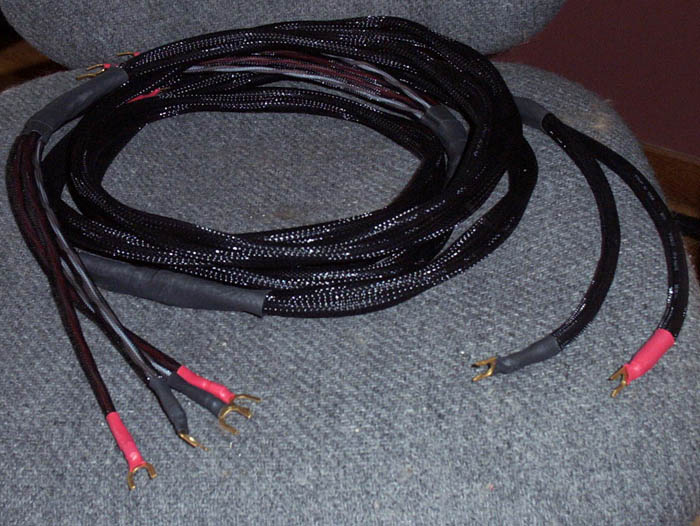



Detail of 5/16" spade connectors at speaker end of cables.
TESTING:
I removed two sets of TMC Gold Label Reference speaker cables (a set biwiring each Studio/60) to hook up MrSandman's DIY cables (hereon referred to as SandCables because it's easier). The TMC's have been my preferred cables for some time now, as they seem to offer the best clarity, detail, balance, and openness for my system. They're very, very stiff, though, so hooking them up can be a real pain. The SandCables are relatively flexible, and were quite a bit easier to connect.

My first impressions were that they sounded a little harsh. My wife's comment was that they were too brassy. They hadn't been burned in, though, and I try not to pass judgment until a component or cable has "settled in" to my system. I left the radio playing a lot for the first few days, and when I watched a movie that weekend I didn't detect a significant difference in the system's sound. It was a movie that I hadn't seen before, though, so I figured I'd wait a bit more and try it with some familiar music.
I listened to an assortment of material over the next month without really sitting down to scrutinize the sound closely. While I had a sense that there might not be as much detail in what I was hearing, they seemed like pretty good performers overall. I expected to be shuffling some components in August, so I waited for that to try a head-to-head comparison of the SandCables and the TMC's that I had been using previously. When that day came, I started out leaving the SandCables in place so that I wouldn't invalidate the testing that I was doing on some other equipment. One particular track on a recently remastered Peter Gabriel collection struck me as odd-sounding at one point during that test. In particular, the low end seemed a bit muddled. After some back and forth between two different pre/pros, I stopped and hooked up the TMC's. The TMC's are clearer and "cleaner" sounding than the SandCables, without a doubt. The TMC's remain my favorite cables. Of course, those same TMC's similarly outperformed the Monster M.75's and BetterCables Premiums, and were on par with the Transparent Music Wave Supers (better suited to my tastes, actually, and at about 20% or less of the retail price). I'd rank the SandCables as equal to BetterCables Premiums and the more exotic Monster stuff. They also have a look that is very comparable to the BetterCables stuff, actually, when it comes to build quality. Pretty impressive stuff, and a definite step up from the Monster XP and Home Depot 12ga that I used a little over a year ago.
CLOSING THOUGHTS:
There are a lot of home theater and two-channel fans who have discovered that it is possible to create some very good cables by doing it yourself. For a somewhat extreme example, some people have used Category 5 network cable to create speaker cable, braiding the individual insulated conductors into a giant mass of a cable and terminating it. MrSandman's SandCables are a fairly straightforward approach to DIY cabling, with some off-the-shelf cable that's available in bulk, the DIY'er's termination style of choice, and some heat-shrink to pretty it up a bit. They didn't replace the TMC's as my personal cable of choice, but they still did an impressive job and represent a very good value. I would certainly recommend trying some sort of DIY speaker cable approach like this for a budget-sensitive home theater or stereo system, a second system, or for long speaker runs such as surrounds or dedicated home theater rooms with remote equipment racks.
EQUIPMENT LIST:
If you have any questions about this review, click here and I'll get back to you as quickly as I can.